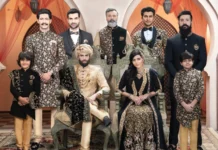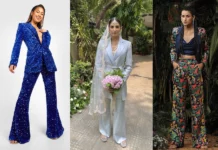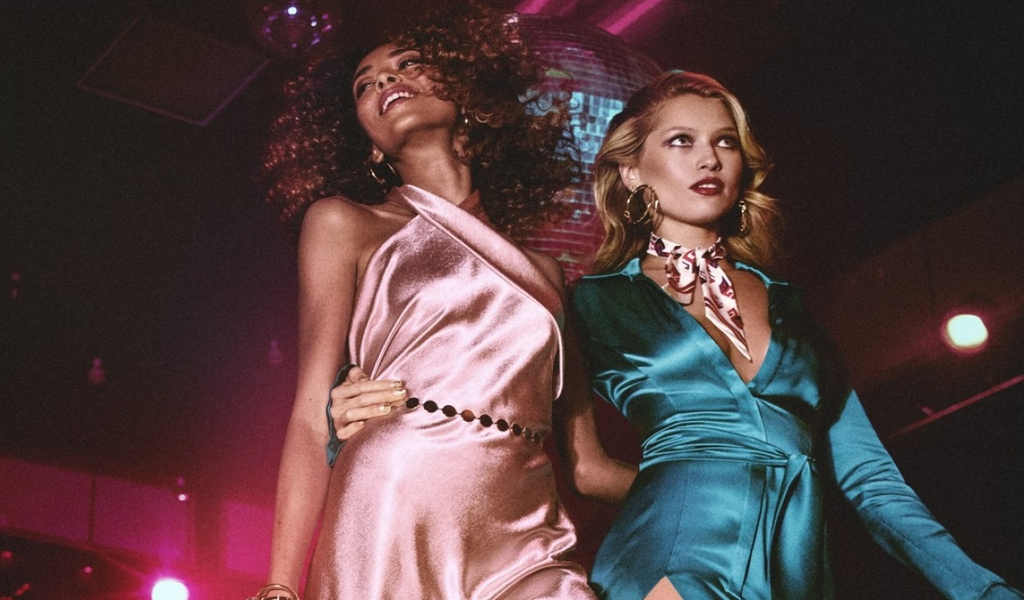“We need houses as we need clothes, architecture stimulates fashion. It’s like hunger and thirst – you need them both.”– Karl Lagerfeld
For long nature has been the muse for splendid work brought out on couture. But now, even the man made creations, the architectural marvels have risen to be the muse of fashion designers, its aesthetic is now provoking creation.

In the basis of construction, both fashion and architecture are interlinked, producing designs through a combination of edges, pleats, surfaces and textures. These simple and elegant edgy cuts and motifs are paving the new path of sensuality towards romanticism. Though the dresses and resort-wears have been the pioneers in being the architectural designs, bridal couture, specifically Indian wear have gained a familiarity with this inclination. Be it temple art, the magnanimous of mosques or simply the architectural icons of a country, the brigade of fashion designers is turning towards this movement taking cues from every nook and cranny. The man-made structures are now as inspirational as nature has been. From the runway weeks to the international red carpets, different designers from around the world have captured the architectural essence through their collections to give a fresh round of reshuffling done to our wardrobes. Pinakin Patel, a designer who creates both–silhouettes in couture and in the architectural marvels, shares how architecture has a part to play in his collections. After his successful debut in Lakmé Fashion Week Summer Resort 2016, he has marked a presence in the sartorial world. He says, “In the new age, as buildings become iconic, it is art and fashion that inspire architecture. My inspiration is the post-deco to pre-modern era time period. My designs portray the refinement of that era.”

Bringing the architectural designs on the couture Though it is the cuts that define a garment into the cluster of architectural fashion innovations, of late, the motifs and even the colour inspirations for the elaborately done Indian wear tell a different tale, drifting from the conventional perception. Talking about her recently created architecture inspired collection ‘Romancing Rococo’, Designer Mandira Wirk shares, “The intricacy of designs in the Rococo movement’s art and architecture as well as the elaborate curves and meticulous grid work serve as the prime source of inspiration. They are brought to life through the medium of intricate and florid thread work, which are restricted to a tone-on-tone palette to keep it sophisticated yet subdued.”
Mandira Wirk’s ‘Romancing Rococo’ takes cue from the curlicues motifs and gilding of the iconic era and finds a modern day expression in her decidedly trans-seasonal collection. She adds, “My collections will always have a hint of architectural marvels, last year we spoke about the immense beauty of the harems of Jaipur and this time the delicateness, elegance and asymmetry of the 18th century artistic movement of Rococo found a contemporary manifestation in our collection. The Rococo movement emerged as a rebellion against the rigidity of Baroque designs and its hallmark was quiet a grandeur that was far from opulent or overbearing. My collection captures this exact sentiment and strives to bring forth elegance that is, at no point, over the top or gimmicky.” Some other collections by various designers have seen minimal hand-embroidery with rich focus on bespoke fabrics and ensembles. It is not just conveying the design aesthetics of a part of the world through the couture; it is also carrying the essence of the land in the ensembles.
Anita Dongre’s ‘Love Notes’ brought to life her love for Rajasthan through bright prints and pastels in cotton georgettes and Chanderi silks. These occasion wears including a semblance of classic suit and lehenga-cholis, spoke of Rajasthan being their inspiration at every thread.
The coming of age designer Karan Arora too has brought some splendid couture inspired from the realm of ancient Mughal architecture. He shares that one of his recent designs is inspired by the finest carvings of the floral patterns and Mathura art in the Taj Mahal’s interior dome and arches, with the ensemble pearl art done on Malda silk. “Symmetric and detailed elements in the architectural aspect along the defined proportion of various elements like living objects, floral placements, along geometric alignment influence my artwork a lot. One of its kinds has been exhilarated by the architectural designs of carving and engraving at the Motibagh Palace & Baradari Garden which was in then princely state of Patiala,” he adds.
The rise in the influence of the middle-eastern architecture on the embroideries and the designs on the couture collections is visible unmistakably. Speaking of inspiration coming at any moment from any place, Designer Suneet Varma shares the insights about his latest architectural muse, the Topkapi Palace, the grandeur of the Ottoman Empire in Istanbul, Turkey which is now a museum holding fine examples of Ottoman opulence. The palace inspired his collection ‘Couture–A Love Story’, which he presented at the IBFW 2015. “The grandeur of the Ottoman Empire and the beautiful poetry of the renowned poet Omar Khayyam who was one of the greatest Persian philosophers and poet who wrote the love couplets in ‘The Rubaiyat’ are all incorporated in my collection. This couture collection is based on the arts and literature of Persia–the love poems, the lyrical motifs, the decorative arts in architecture, the Persian blues, the soft pastels and the nostalgic shades of gold and rose,” says the art infused designer.
The ‘Mahal En Maroc’ collection by SVA too highlighted the motifs from the land of Morocco, with the historic tiles and minarets of Hasan II mosque in Casablanca transcending into prints and intricate embroideries on the soft flowing dreamy drapes. The design inspirations translated beautifully on the summery crop tops, layered jackets and lehengas for the women, while the Indian kurtas and dhotis for men got a different twist with Moroccan influence. These mixes with new experiments done on them are getting thumbs up from the prospective grooms and the brides for a refreshed feel to their trousseau.
Why it works?
- These drapes bring out the perfect frame of the body, accentuating the different looks you want to carry for different events and ceremonies. If every detailing is giving attention, these shapes can provide a person of straight frame the much needed contours.
- They are great in helping you to conceal the parts of your body you don’t want to make a cheerless impression. While the floor-fluid gowns for the reception will augment the mystic feel, the figure hugging upper portion with defining architectural and geometric cuts will flow around your curves, carving out the desired shape. The incredible angles and lines, the definite shapes, and the extensive designs, all blending together harmoniously will somehow get all the eyes on you.
- The trend, seen more popular in western outfits, is more about highlighting sculptural shoulders, hips, high collars and the waistline through ensembles in pleats, crafty draping and a sense of femininity and refinement.
- The edgy silhouettes boast of elegance with peplum shapes, wavy pleats, angular tailoring and ruffled folds and pleats cascading down a dress. From the bridal wears to the casual wears, the architectural imprints can be seen everywhere. One finds highly sculpted tops, jackets and skirts while searching among the options in the architectural designs, but what is important is to choose the ones that are even structured well, especially for cocktail dresses and gowns.
- Highlighting the waist is another way to carry this look, with flouncy tops with waist ruffles or mid floor-length dresses with peplum detailing at the waist for a party thrown by a dear friend.
- On the ethnic side, for the Indian wears, you just need to style them the way you usually do, because here it is the embroidery and design that is played with more along with the cuts and tailoring.
Let your styling leave the space for the splendid cuts to make their impression, and remember, “Fashion is architecture: it is a matter of proportions,” as said by Coco Chanel.










